WDM is a technology that converges multiple optical signals of different wavelengths through a combiner and couples them into the same fiber for data transmission.
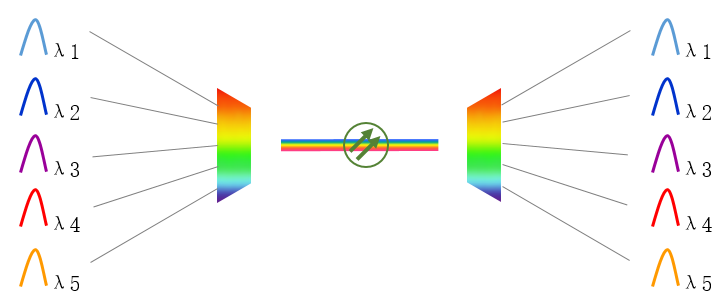
Working principle of WDM
Wavelength x frequency = speed of light (constant value), so WDM is actually the same with frequency division multiplexing.
To put it simply, we can think of WDM as a highway——where different types of vehicles rush in and then go their separate ways when they get to their destination.
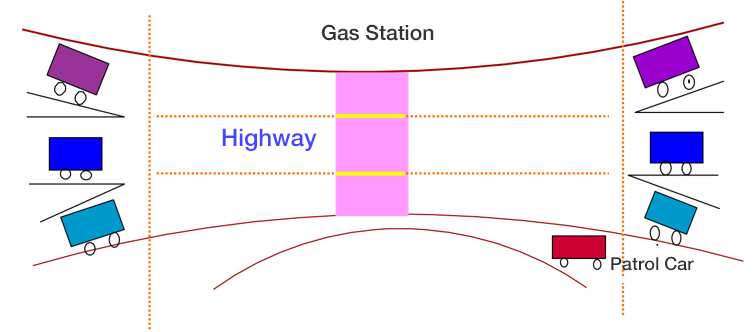
The role of wavelength division multiplexing is to improve the transmission capacity of optical fiber and the utilization efficiency of optical fiber resources. For the WDM system, to make it work normally, it is obvious that the wavelength (frequency) of each optical signal must be controlled. If the wavelength interval is too short, it is easy to “crash”; If the wavelength interval is too long, the utilization rate will be very low.
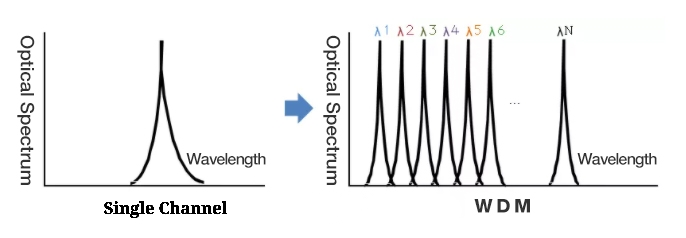
At first, the technical conditions were limited, and the wavelength spacing would be controlled within tens of nanometers. This type of WDM is called Coarse Wavelength Division Multiplexing(CWDM).
Later, the technology became more and more advanced, and the wavelength interval became shorter and shorter. It was called Dense Wavelength Division Multiplexing(DWDM) when it reached the level within a few nanometers.
CWDM has a wavelength spacing of 20nm and 18 wavebands from 1270nm to 1610nm.
|
Wavelength Number |
Central Wavelength |
Wavelength Number |
Central Wavelength |
|
1 |
1471 |
10 |
1291 |
|
2 |
1491 |
11 |
1311 |
|
3 |
1511 |
12 |
1331 |
|
4 |
1531 |
13 |
1351 |
|
5 |
1551 |
14 |
1371 |
|
6 |
1571 |
15 |
1391 |
|
7 |
1591 |
16 |
1411 |
|
8 |
1611 |
17 |
1431 |
|
9 |
1271 |
18 |
1451 |
However, due to the obvious attenuation increase in the wavebands from 1270nm to 1470nm, many old type optical fibers cannot be used normally, so CWDM generally gives priority to the use of the 8 wavebands from 1470nm to 1610nm.
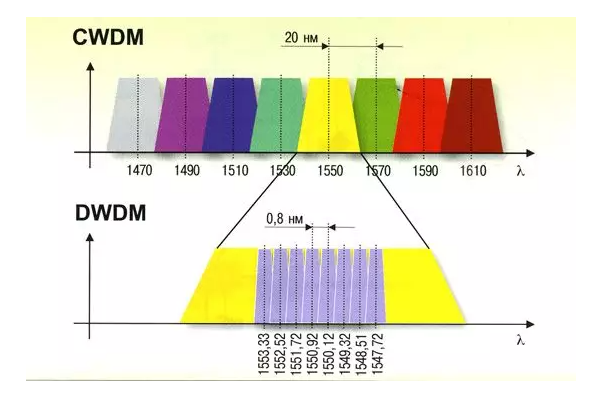
CWDM to DWDM
The wavelength spacing of DWDM can be 1.6nm, 0.8nm, 0.4nm, 0.2nm, which can accommodate 40/80/160 waves (up to 192 waves). The wave range of DWDM is 1525nm to 1565nm (C band) and 1570nm to 1610nm (L band).

CWDM to DWDM
DWDM is commonly used in C-band, with a wavelength interval of 0.4nm and a channel frequency interval of 50GHz.
A summary comparison of CWDM and DWDM:
|
|
CWDM |
DWDM |
|
Full Name |
Coarse Wavelength Division Multiplexing |
Dense Wavelength Division Multiplexing |
|
Wave Interval |
20nm in general |
0.8nm/0.4nm/0.2nm/1.6nm |
|
Wave Range |
1270nm to 1610nm |
1525nm to 1565nm (C band) |
|
1570nm to 1610nm (L band) |
||
|
Numbers of Wavebands |
18 |
40/80/160 (up to 192) |
|
Optical Modulation Form |
Uncooled laser, electronically tuned |
Cooled laser, tuned by temperature |
|
Cost |
Low |
High |
|
Communication Distance |
Short (Optical amplifiers unsupported) |
Long |
MWDM vs LWDM
Nowadays, 5G network is blooming. When the Communications Service Providers (CSP) build 5G fronthaul network, they always fall into a dilemma: if they choose the more active WDM with higher operation and maintenance efficiency, the cost will increase; If we choose the low-cost passive WDM mode, it is difficult to improve the operation and maintenance efficiency, and it can not match the business needs in the future. Therefore, CSPs hope to find a way to deploy 5G fronthaul network to realize both cost and operation efficiency. In this case, open WDM was born.
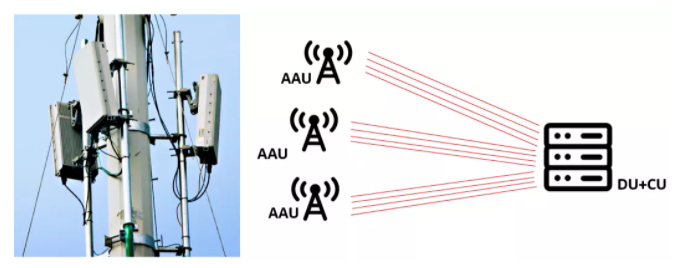
Application of 5G fronthaul network
The principle of MWDM(Medium Wavelength Division Multiplexing), is to focus on using the first 6 waves of 25G CWDM, by adding TEC (Thermal Electronic Cooler) for temperature control, then left and right offset 3.5nm wavelengths to form 12 wavelengths, this solution can save a lot of fiber resources.
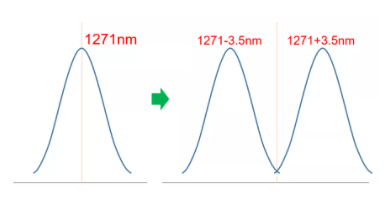
MWDM:6 wavelengths increase to 12 wavelengths
Then about LWDM(Lan Wavelength Division Multiplexing), LWDM is Ethernet channel-based wavelength division multiplexing (LAN WDM), with a channel spacing of 200 to 800 GHz, a range between DWDM (100 GHz, 50 GHz) and CWDM (about 3 THz).
|
Wavelength |
Application Scheme |
Industrial chain |
|
1269.23 |
DWL+PIN |
/ |
|
1273.54 |
DWL+PIN |
Share 400G LR8 industry chain |
|
1277.89 |
DWL+PIN |
|
|
1282.26 |
DWL+PIN |
|
|
1286.66 |
DWL+PIN |
|
|
1291.1 |
DWL+PIN |
/ |
|
1295.56 |
DWL+PIN |
Share 400G LR4 industry chain |
|
1300.05 |
DWL+PIN |
|
|
1304.58 |
DWL+PIN |
|
|
1309.14 |
DWL+PIN |
|
|
1313.73 |
DWL+PIN |
/ |
|
1318.35 |
DWL+PIN |
/ |
DML (Directly Modulated Laser) is at the transmitting end(TOSA) of the optical module, and its counterpart is the EML (Electro-absorption Modulated Laser), which is more costly. And PIN refers to the light-emitting diode at the receiving end(ROSA) of the optical module.
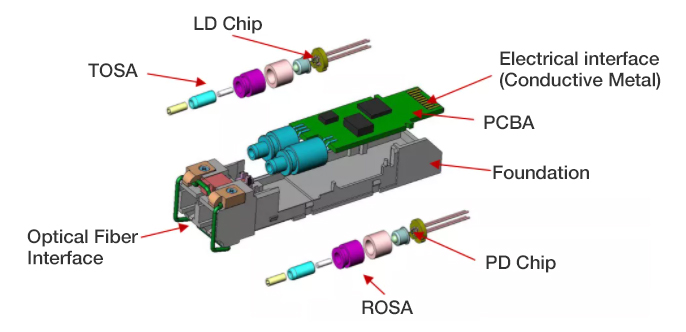
The internal structure of an optical module
SOPO focuses on providing optical communication solutions for customers, including design, R&D, manufacturing, and one-stop customized production. The main products are WDM, optical transceivers, PLC splitter, optical fiber connector, etc. The products are widely used in FTTH, Data centers, 5G networks, telecommunication networks.
Last: Telecom sector will shine in post Covid-19 era, says GlobalData